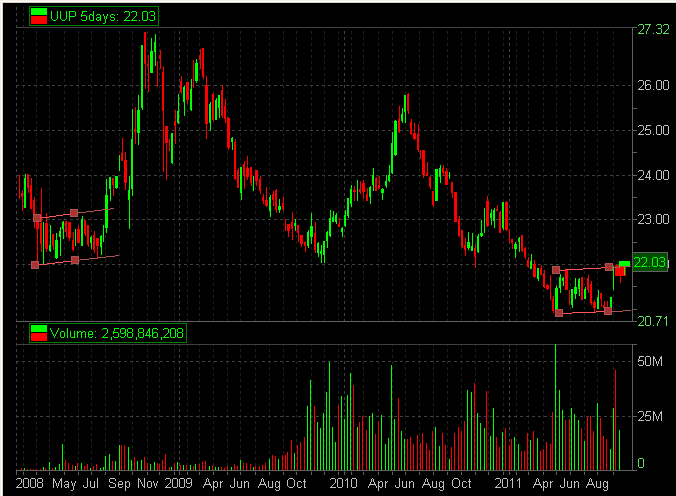This is a guest post from Fred Barnes aka @DCDaytrader:
I recently had a conversation with a few somewhat novice traders. For us traders who don’t have the 2007-2008 market experience on our resumes, we’re looking at the recent market activity in awe. Watching the quote screen (of the $ES_F) in August (2011) required the skills of a speed reader. The volatility was nothing short of amazing, but one learns quickly that fire burns.
The commentary being discussed by these somewhat novice traders is trying to determine which side of the market to be on at any given moment throughout the trading day. Obviously that is understandable due to some of the wide price swings we’ve had the past few weeks, but constantly flipping one’s trading mentality from Bull to Bear (especially as an intraday trader) can cause added pressure and confusion on a young trader (I would guess this is a problem for old timers too).
For me, keeping a certain mindset has helped keep things in perspective. (I have to attribute this concept to a trader friend of mine, Leonard Novy (Novy Principles of Market Flow)). Because of this concept, I see the markets much clearer; I am able to decipher moves much easier; and more importantly I am able to stay in tune with the market storyline (note: I am an investigator by trade, so I have to find the story in the market. I believe the market leaves “footprints” or clues as to what is the prevailing opinion of its participants). Allow me to explain my mindset and share the lens I look through when assessing the markets:
BULLISH THINKING DOMINATES ALL MARKETS. The markets are designed to be a LONG side vehicle to create growth and income. If a market is attempting to bottom then we normally are examining a bullish base building area. Hint: take a look at a Weekly Chart of the USD Index, specifically the March-July 2008 basing area and compare that to the recent area of basing from May2011 – present. If a market is creating a top, then normally that can be seen as bullish profit taking. These initial stages of profit taking will eventually turn to concern if accumulation is not confirmed (which can take some time), as every dip is considered a buying opportunity.
BEARS ARE OPPORTUNISTS AND CANNOT CAUSE A BEAR MARKET. Bears can pile up on bulls at perceived tops (shorting), but if the shorts keep finding buyers below, then the market will not go lower. The shorts may continue to try and overwhelm buyers, which can result in a few weak hand longs being shaken out (especially those that bought too high to stay in the move), but the entire thought process has to change from greed to fear before the bulls let go of their positions. As the saying goes: Fear is stronger than greed, which is why financial markets fall more rapidly than they climb.
Bears will enter the market when they see the commitment level of bulls waning: failed accumulation at tops or failed accumulation at bottoms. In either scenario, bears look for opportunities to exploit disappointment at failed accumulation (this occurs in every time frame, and it is particularly interesting to watch on shorter timeframes).
In upward-bound trends, bulls become bold and cavalier-like with their buy-the-dip mentality; this continues until enough failed accumulation attempts causes them to give up a particular area, which generally results in what I like to call a “pile on short” (momentum). Early success in accumulation makes bulls less fearful. As the accumulations struggle to take hold later on, the bulls become more cautious. It’s the failed accumulation that turns cautious bulls into fearful bulls. The market can only go lower if the bulls fail at confirming accumulation; if the bears fail at confirming distribution it’s because the bulls are absorbing sell orders.
Look at a chart and see if you can determine where the Bullish commitment level started to waiver. What happened. What happened when the bulls turned from fearful to greedy and started a base building effort? Follow the storyline and Think like a BULL.
Follow me on Twitter and Stocktwits @ DCDaytrader


5 Comments on “Bears Don’t Exist, Think Like a Bull”
I read the comments to barnes on twitter.
This really is the fred barnes from politics.
hey fred. How do you have time to do this and report politics, too?
Nope, sorry, i take it back.
it’s not fox fred barnes, it’s a liberal fred barnes.
So one question, if the bias is bullish in the USD index, doesn’t that imply a negative bias to EUR, GBP, JPY ect? Thanks for your insight, great post!
it could yes, but the Dollar Index example was more of a visual example of the point I was trying to make….
it could yes, but the Dollar Index example was more of a visual example of the point I was trying to make….